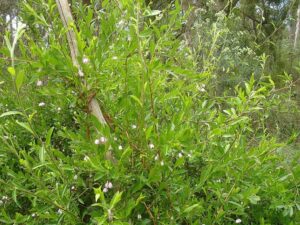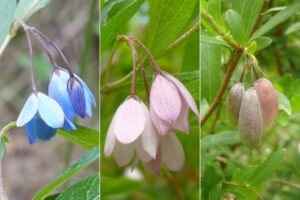
A weed by any name!
By Clive Larkman
Weeds are a pain for any gardener or commercial horticultural farmer. In fact, anyone who has to manage a piece of dirt or soil has issues with weeds. Books, articles, videos, companies, and even government departments debate and discuss weeds and their effects on our lives.
The first issue is to define a weed. When taken at its most basic, this definition is actually simple.
The dictionary defines a weed as “any plant growing where it is not wanted.” This has always been my preferred phrase.
There are of course more technical definitions:
Wikipedia:
A weed is a plant considered undesirable in a particular situation, growing where it conflicts with human preferences, needs, or goals. (not a bad definition!)
The Australian Association of Bush Regenerators:
A weed is any plant that colonises and persists in an ecosystem in which it did not previously exist. They may affect the economy, the environment, human health and amenity.
New England Weeds Authority
A weed is a plant that is growing out of place. They may be in a location or at a time that man considers to be inappropriate.
Artificial Intelligence (AI)
Any wild plant that grows in an unwanted place, especially in a garden or field where it prevents the cultivated plants from growing freely.
Hippies
Any plant with the Latin name Cannabis sativa = Marijuana
Weeds create nearly as much passion in the community as a discussion on climate change. Based on how they affect us, weeds can be divided into three groups. Many weeds are just annoying but are easy to control and have no financial effect on the economy. Some weeds are important but are usually localised and outside any legislative actions.
The other two types of weeds are agricultural and environmental weeds. These are viewed on a national or statewide basis. The environmental weeds generate a lot of passion in the community and can be very local up to nationwide. Sometimes, it is just the visual sight of non-indigenous plants growing in the natural bush. The weeds may not cause any damage to native plants but are just annoying. The other extreme is where the weed causes significant environmental damage, loss of habitat and even displacement of native species.

The latter type of weeds are rarely banned but can be listed under Weeds of National Significance or National Environmental Weeds. Although all states have lists of these weeds, it is really only Tasmania and Western Australia that take a proactive stance on listing them and banning or restricting their movement across the borders. Western Australia has a list, and all plants are banned unless they are on the permitted list. This is unique in the world and causes a lot of issues for the amenity horticultural industry.
Local councils may also restrict the sale or movement of these weedy species, although these laws are weak and hard to enforce. Also, local councilors can be greatly influenced by their thoughts. Some are passionate about native plants and believe that anything not indigenous should be banned.
Agricultural weeds are much more intensely monitored. They are nearly always defined under state rules rather than national or local laws. There is a lot of confusion in this sector, compounded by varying legislative actions that change from state to state. One of the significant errors is the use of the term noxious. A noxious weed is not any weed that is a major environmental or agricultural problem, it is a plant species that is considered a serious threat to primary production or occasionally the environment, and is subject to specific control and management measures by the state governments. To be a noxious weed it must be declared and legislated as such by a state government.
Noxious weeds are nearly always classified at the species level. Some are declared at sub species level and a few at genus level. The latter is rare and would only relate to small genera. When declared by a state, they are also listed as banned imports into Australia by Biosecurity Australia. There has long been a push to enable individual cultivars to be removed from the declared lists if they can be proven to be sterile, and if the weediness is caused by seed production and dispersal. If a weed is invasive due to asexual propagation (e.g. most aquatic weeds) the viability of the seed is irrelevant and the damage is usually worse.
Confusion is then increased because each state has its own rules on how a ‘noxious’ weed is to be treated. In Victoria, prior to the mid-nineties, these weeds were defined differently in different water catchment regions. In some areas, a declared weed had to be removed by the landholder, removed by the department, or left on the land, but it could not be propagated or grown, and was not sold. The state government changed this so that if a plant was declared a weed in one region, it is a weed everywhere, but the legislated actions are still different. The worst of the worst must be removed if found by the landholders, and the Department of Primary Industries must remove them if they are made aware of them. However, they don’t have the funding and no longer take any real action. Each state has similar sets of rules and definitions on weeds.
There is an added complexity in Australia as many weeds are state-specific due to the climatic conditions. An example is the curry tree Murraya koenigii, a declared weed in Queensland that is very hard to grow in Victoria as it needs sub-tropical to tropical conditions. Then there are the nomenclature problems with common and Latin names. Wild rocket refers to both Eruca sativa and Diplotaxis tenuifolia one of which is weedy but not an issue, and one (the latter) is a declared weed. Both are grown commercially and can be found in some markets.
Finally, there is the problem with some native plants that are classed as weeds. Sollya or Billardiera heterophylla is native to southern Western Australia where it is an attractive wild climbing shrub. It has now become an environmental weed in Victoria’s Mornington Peninsula. Pittosporum undulatum is native to eastern Australia, from southern Queensland to eastern Victoria. It has now become an environmental weed in areas around Melbourne. It is hard for the community to grasp how a native plant can become a weed, so they often don’t consider weediness an issue. They are not declared noxious weeds, but can be as defined environmental weeds – again, local or statewide, but not national.
So, the whole issue is a minefield, but it is critical that everyone working in the industry understands the main difference between what is noxious, environmental, or just annoying.
